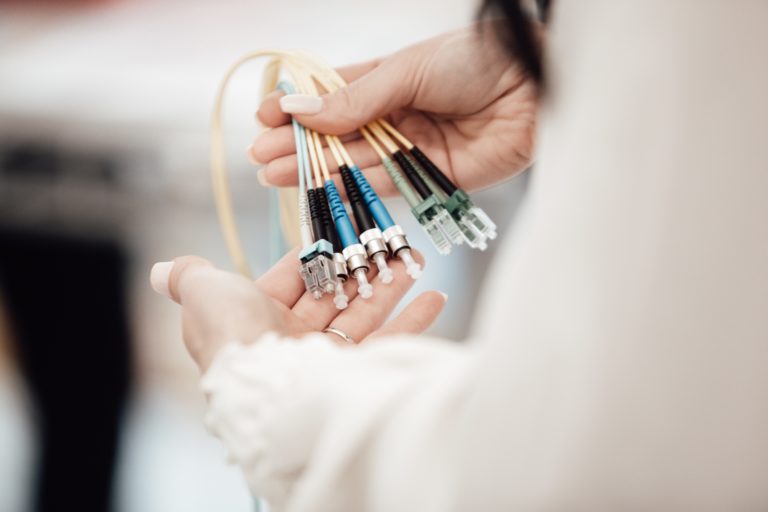A good internet connection has always been vital to effective business communication, especially in the 21st century. The connection you choose influences the satisfaction of your employees, clients, and potential partners. It directly affects your productivity, reputation, and efficiency on a day-to-day basis. This choice can seriously affect your business outcomes.
Perhaps one of the longest-standing debates in the history of the internet has been the efficiency of cable internet and that of fiber internet. While both of them work extremely well, each service type has certain pros and cons that are irrefutable.
To a common person, the meaning of cable internet and fiber internet are pretty much synonymous. However, these two internet types could not be any more different. In this article, we hope to educate you on the basics of cable internet and of fiber connections. This way you will be able to make smart choices for your business needs in 2022.
What Is Cable Internet Connection?
Cable internet basically shares the technology and infrastructure with a cable TV connection. It uses a coaxial or coax cable to transmit data over a certain distance. The wiring has a central copper core that is heavily insulated around with aluminum and a plastic outer sheath.
A coax cable is capable of supplying a television network and an internet connection simultaneously. This allows many service providers like Xfinity Internet to bundle TV and internet deals together to get the maximum use out of a single subscription.
What Is Fiber Internet Connection?
A fiber internet connection is transferred using a fiber optic cable. What is a fiber optic cable you ask? Well, a fiber optic internet cable is made up of plastic or glass (usually glass) and transmits signals in the form of light. The best part about fiber cables is that these tiny thin strands of fiber can carry digital information over extremely long distances. This occurs without any loss or compromise in the information or signals.
The fiber internet cable is of two kinds and hence, designed for two different uses. The Direct Internet Access (DIA) fiber usually is allocated for direct line operations over a secure network for large corporations who cannot afford any kind of downtime. It is extremely reliable and has immaculate security screening and monitoring.
The Broadband Fiber-Optic Network on the other hand is a network type that is more suited to users in residential areas or small businesses. It has lower installation costs than the DIA and hence, is a little less reliable too.
Cable vs Fiber: What Is the Better Choice?
In the United States, about 89% of the internet on land coverage is through cable alone. Cable infrastructure is not costly and takes little effort to set up hence is available in most places across the nation.
In contrast, since the technology is a little high-end, fiber cable is not available everywhere across the country. It covers about 25% of land in the USA with the heaviest coverage being in the metro areas while some rural areas have little to no access to fiber internet.
The speed tiers of cable internet and fiber networks vary drastically too. The download speeds on a typical cable network can be expected to be anywhere between 10 to 500 Mbps with even lower upload speeds.
However, these speeds usually are good enough for home use or small businesses to operate on. Although one downside for cable internet is that in crowded neighborhoods, you can expect a reduction in your internet speeds during certain peak hours of the day.
Fiber internet does not have the same restrictions. The service is known for its high internet speeds, almost instantaneous service, with speeds ranging between 250 to 1000 Mbps for both downloads and uploads. Quite fascinating, isn’t it? You don’t have to wait around for that movie to download after all!
When we talk about cost, the cable is certainly the more economical service of the two. Fiber costs have come down a great deal over the years, but it still is quite expensive. The infrastructure for fiber is quite exuberant and so the end-user cost definitely increases quite a bit.
Also Read: WHAT IS SEO / SEARCH ENGINE OPTIMIZATION?
Final Word
Cable internet and Fiber internet are both excellent internet services that keep up their end of the bargain by taking you online. Both these service types have their good and bad. With cable, your speeds will never be cheetah fast but it is available a lot more widely than fiber internet. It is also more cost-effective and works for most residential settings so if you are looking for a good, and cheap internet option – cable internet is your answer.
If however, you prefer things to be faster and fancier, fiber may be your best bet. Perhaps you own an expanding business and need a secure and reliable internet option. Or maybe you are a gamer and want extremely fast internet speeds to perform great? Well, under those circumstances, fiber internet would probably be a better choice for you.
You can also choose Xfinity Internet that supplies both cable and fiber internet – and just make things easier for yourself.
Remember, you do you!








